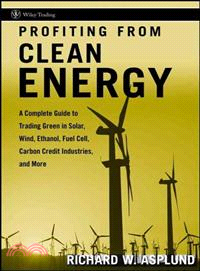| FindBook |
有 1 項符合
PROFITING FROM CLEAN ENERGY: A COMPLETE GUIDE TO的圖書 |
 |
PROFITING FROM CLEAN ENERGY: A COMPLETE GUIDE TO 作者:Richard W. Asplund 出版社:JOHN WILEY & SONS,LTD 出版日期:2008-02-04 規格: / 370頁 |
| 圖書館借閱 |
| 國家圖書館 | 全國圖書書目資訊網 | 國立公共資訊圖書館 | 電子書服務平台 | MetaCat 跨館整合查詢 |
| 臺北市立圖書館 | 新北市立圖書館 | 基隆市公共圖書館 | 桃園市立圖書館 | 新竹縣公共圖書館 |
| 苗栗縣立圖書館 | 臺中市立圖書館 | 彰化縣公共圖書館 | 南投縣文化局 | 雲林縣公共圖書館 |
| 嘉義縣圖書館 | 臺南市立圖書館 | 高雄市立圖書館 | 屏東縣公共圖書館 | 宜蘭縣公共圖書館 |
| 花蓮縣文化局 | 臺東縣文化處 |
|
|
- 圖書簡介
With Profiting from Clean Energy, respected investment analyst Richard Asplund provides an in-depth explanation of the technology and industry structure behind various sectors of this field and in the process identifies more than 150 stocks related to clean energy. Along the way, Asplund discusses exactly what it takes to effectively invest in clean energy—whether it be through buying individual stocks, investing in green exchange-traded funds or mutual funds, or trading the biofuel and carbon credit markets.
- 作者簡介
Richard W. Asplund is a professional investment analyst and advisor with twenty-five years of experience. He received an MBA cum laude from the University of Chicago Graduate School of Business, a juris doctor degree from the University of Wisconsin-Madison, and a bachelor of science degree in industrial engineering cum laude from the University of Minnesota. Asplund founded his own investment research firm in 1983 and is currently a professional equity analyst and advisor specializing in clean energy stocks. He has been interviewed on CNBC, Fox, Bloomberg TV, Japanese NHK TV, and National Public Radio, and has been quoted in print publications such as Dow Jones, Reuters, USA Today, Newsweek, and others.
- 名人/編輯推薦
"…offers readers a thorough guide to the basics of clean energy investment opportunities". (City AM, Tuesday 17th March 2008)
- 目次
Introduction.
Chapter 1. Clean Energy Investments and Performance - The Show Has Just Begun.
Clean Energy Business Startup.
Angel Investing.
Venture Capital.
Publicly Traded Stocks.
Clean Energy Stocks Listed Outside the US.
Large-cap Stocks.
Global Petroleum Companies.
Clean Energy Exchange Traded Funds (ETFs) and Mutual Funds.
Clean Energy - Exchange Traded Funds (ETFs).
Green Mutual Funds.
Global ETFs and Green Mutual Funds.
Futures and Options.
Investment Criteria for Publicly-Traded Stocks.
Valuation and Bubbles.
Clean Energy Stock Performance.
Chapter 2. Catalysts for the Clean Energy Industry.
Fossil Fuel Negatives – Pollution, CO2 Emissions, Cartels, Price Spikes, and Rising Prices.
Energy Security.
Growing Global Energy Demand.
Greenhouse Gas Emissions and Climate Change.
Clean Energy Technology Improvements.
Demand for Distributed Power Solutions Due to Grid Unreliability.
Rising Electricity Prices.
Could the Clean Energy Movement Fizzle if Oil Prices Plunge?
Clean Energy Catalysts - Investment Conclusion.
Chapter 3. The Government Push - Strong Enough to Get Clean Energy to Fossil Fuel Parity?
Types Of Government Clean Energy Incentives And Mandates.
Renewable Energy Targets Worldwide.
Government Clean Energy Support Initiatives in the United States.
A Post-Kyoto Carbon Emissions Framework.
Chapter 4. Clean Energy Potential - Double-Digit Growth for Decades.
Overview of Global and US Energy Flows.
Overview of US Electricity Generation Sources.
Fossil Fuel Market Size - Even a Nose Under the Tent is Worth Billions.
Renewable Energy Forecasts.
Chapter 5. Solar Power - The Sky is the Limit.
Solar Thermal Power.
Solar Photovoltaic Power.
Solar Power Industry Growth Rates.
Demand Generated by Government Incentives and Regulation.
Solar Power Pricing and Competitiveness.
Solar Power Pricing and Competitiveness.
Upstream Solar Players - Polysilicon & Wafer Producers.
Thin Film Threats to Crystalline Silicon Solar Cells.
Upgraded Metallurgical Silicon (uMGS)—A Threat to Traditional Polysilicon Producers?
Solar PV Cell and Module Producers.
The Outlook for Solar Cell/Module Manufacturers.
Investment Criteria for the Solar PV Industry.
Chapter 6. Wind Power - The Picturesque Dutch Windmill Gets a Technology Makeover.
Advantages and Disadvantages of Wind Power.
How Do Wind Turbines Work?
Technological Developments.
Offshore Wind.
Industry Growth Rates and Prospects for Future Growth.
The Economics of Wind Power.
Government-Sponsored Incentives.
Wind Industry Issue - Component Shortages.
Wind Industry Players.
Chapter 7. Fuel Cells - Present & Accounted for in Some Applications Already.
Advantages and Disadvantages of Fuel Cells.
What is a Fuel Cell? - Overview of the Technology.
Fuel Cell Industry Analysis - Industry Players.
Fuel Cell Industry Target Markets.
Commercialization Challenges.
Chapter 8. Geothermal Power - Dante's Contribution to Clean Energy.
Advantages/Disadvantages of Geothermal Power.
Geothermal Resources.
The Extraction of Geothermal Energy.
Geothermal Power Plant Systems Under Development.
Geothermal Heat Pumps.
Economics of Geothermal Power.
The Future of Geothermal Energy.
Chapter 9. Cleaner Utilities - Teaching an Old Dog New Tricks.
Green Power Marketing Programs.
Renewable Energy Certificates.
Sources of Renewable Energy.
Methane Gas Extraction.
Companies Operating in Biomass and Biogas.
Wave and Tide Power.
Chapter 10. Power Efficiency – "The Cheapest and Most Available Source of Energy Is the Energy We Waste".
Efficient Appliances.
Efficient Lighting.
Efficient Buildings - Green Buildings.
Companies Involved in Building Efficiency.
Chapter 11. Smart Meters - Getting Smart on Grid Efficiency and Reliability.
Smart Grid.
Demand Response as a Power Efficiency Solution.
The Role of Smart Meters.
Demand Response and Advanced Metering.
Benefits of Smart Meters.
Current Smart Meter Usage.
Advanced Metering Costs and Benefits.
Southern California Edison's Business Case Experience for Advanced Metering.
Interoperability And Industry Standards.
Global Demand Response.
US Regulators - Generally Positive Toward Advanced Metering.
What is Ahead for the Smart Meter Industry?
Industry Meter Penetration Rates and Upgrade Opportunities.
Smart Meter Industry Growth Rates.
Electricity Meter Market Shares.
Chapter 12. Power Storage and Backup Systems - When the Grid Just Won't Do.
Types of Direct Electricity Storage Systems.
Types of Power Storage Systems.
Target Market Sizes.
Chapter 13. Clean Transportation - Electric Hybrids Are Charged Up and Ready to Go.
The Internal Combustion Engine - Can It Be Saved?
Alternative Fuels for the Internal Combustion Engine
Eliminating the Internal Combustion Engine
Hybrid Gasoline-Electric Vehicles
Plug-in Electric Hybrid Vehicles (PHEVs).
Hybrid and Electric Vehicle Players.
All-Electric Vehicles.
Clean Transportation Investment Conclusions.
Chapter 14. Ethanol/Biofuels - US Farmers Play David to OPEC's Goliath.
Biofuels - What Are They?
Advantages and Disadvantages
US Government Support for Ethanol.
Obstacles for the US Ethanol Industry.
Brazilian Competition.
How far Can Ethanol Go to Replace Gasoline in the US Transportation Fuel Supply?
The Future of Ethanol—Cellulosic-Based Ethanol.
Ethanol Company Investment Analysis.
US Ethanol Indusry Market Shares.
Ethanol Investment Conclusions.
Companies Supporting the US Ethanol Industry.
Chapter 15. Trading Biofuel Markets - Feedstock Frenzy.
Ethanol.
Corn.
Sugar.
Soybean Oil.
Palm Oil.
Chapter 16. Big Coal - Meet Your New Partners: Cleaner Coal and Carbon Capture.
Global Coal Usage.
US Coal Companies.
Cleaner Coal Technologies.
Cleaner Burning Coal.
Coal-Fired Power Plant Pollution Controls.
Coal Gasification and CO2 Sequestration.
Algae-based CO2 Absorption.
Coal-to-Liquid Transportation Fuel.
Chapter 17. Carbon Trading - Poised to Become the World's Largest Commodity Market?
Trading European CO2 Allowances.
Causes of Price Movements.
European Cap-and-Trade CO2 Emissions Background Explanation.
Chicago Climate Exchange.
Chapter 18. Investment Conclusions.
Investment Conclusions for Clean Energy.
Investment Risks.
Appendix.
Notes.
Index.
|











